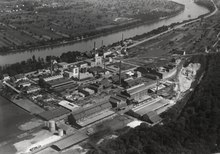Schweizerhalle
Schweizerhalle is an important industrial area in the two Basel landscape communities of Muttenz and Pratteln near Basel, directly on the Rhine . Schweizerhalle belongs to the economic region of northwestern Switzerland and is one of the locations of the Swiss saltworks and well-known chemical companies such as Novartis and Clariant .
Origin of name
The name comes from Schweizerhalle (meaning: Schweizer Halle), an older name of the salt-extracting company Schweizer Rheinsalinen . The part of the name “Halle” denotes the plural of “Hall”, an obsolete word for saline . When the company of the same name was named, it was assumed that “Hall” was a Celtic expression for salt .
Saltworks
On May 30, 1836, the German mining expert Freiherr Carl Christian Friedrich Glenck came across a seven-meter-thick layer of salt near the Red House in Muttenz. Just one year later, the first saltworks was built nearby in the Pratteln municipal ban.
Switzerland and Liechtenstein are supplied with salt through the “ Swiss Saltworks ” . The salt shelf was an important source of income for the still young and poor half-canton of Basel-Landschaft. The large land reserves, the location on the Rhine and the availability of salt were important factors for the establishment of chemical industry production facilities, which in the second half of the twentieth century had no room for further expansion in Basel.
In 1997, the “ The Salt Chamber ” museum was set up in the “Villa Glenck”, the former director's residence, built right next to the saltworks in 1860 .
Major fire on November 1, 1986
Schweizerhalle gained notoriety when a major fire broke out at the chemical company Sandoz on November 1, 1986, as a result of which extinguishing water contaminated with pesticides in particular got into the Rhine, which led to fish deaths downstream to Mannheim . A contamination of the Rhine water with a red dye that had also been introduced, but which was non-toxic, was visible from afar.
literature
- Bernhard Ruetz, in collaboration with Armin Roos: Carl Christian Friedrich Glenck, 1779–1845, salt pioneer and founder of the Schweizerhalle saltworks. Swiss pioneers in business and technology, Vol. 90, Zurich 2009, ISBN 978-3-909059-46-1 .
- Schweizerhalle , Report of the Government Council to the District Administrator (Baselland), 1987.
Web links
- Dominik Wunderlin: Schweizerhalle. In: Historical Lexicon of Switzerland .
- Website of the Swiss Rheinsalinen AG
Individual evidence
- ↑ Experience salt - “Die Salzkammer” museum , salz.ch
- ↑ The salt chamber . museums.ch

